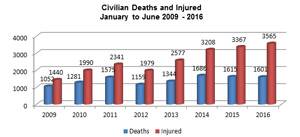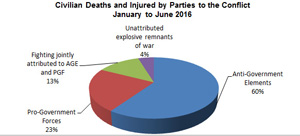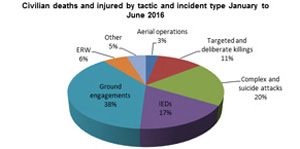Press releases Office of the High Commissioner for Human Rights
Afghanistan: Record level of civilian casualties sustained in first half of 2016 – UN report
Afghanistan: Record casualties
25 July 2016
GENEVA/KABUL (25 July 2016) – A UN report on Afghanistan published Monday shows a record number of civilian casualties since counting began in 2009, with 5,166 civilians recorded killed or maimed in just the first six months of this year, of whom almost one-third were children. The total civilian casualty figure recorded by the UN between 1 January 2009 and 30 June 2016 has risen to 63,934, including 22,941 deaths and 40,993 injured.
Between January and June this year, the Human Rights team of the UN Assistance Mission in Afghanistan (UNAMA) documented 1,601 civilian deaths and 3,565 injured civilians. This represents an increase of four percent in the total number of casualties compared to the first six months of 2015 – and is the highest half-year total since 2009.
This year’s casualties include 1,509 children (388 dead and 1,121 injured) – a figure the UN Human Rights Chief described as “alarming and shameful,” particularly as it represents the highest numbers of children killed or wounded in a six-month period since counting began in 2009.
There were also 507 women casualties (130 killed and 377 injured). The figures are conservative – almost certainly underestimates – given the strict methodology employed in their documentation and in determining the civilian status of those affected.
The Secretary-General’s Special Representative for Afghanistan and head of UNAMA Tadamichi Yamamoto stressed that the report must serve as a call to action by parties to the conflict “to do all they can to spare civilians from the horrors of war.”
“Every single casualty documented in this report – people killed while praying, working, studying, fetching water, recovering in hospitals – every civilian casualty represents a failure of commitment and should be a call to action for parties to the conflict to take meaningful, concrete steps to reduce civilians’ suffering and increase protection,” Yamamoto said. “Platitudes not backed by meaningful action ring hollow over time. History and the collective memory of the Afghan people will judge leaders of all parties to this conflict by their actual conduct.”
“The testimony of victims and their families brings into agonizing focus the tragedy of each one of the 63,934 people killed or maimed by this protracted conflict since 2009,” said UN High Commissioner for Human Rights Zeid Ra’ad Al Hussein. “The family that lost a breadwinner, forcing the children to leave school and struggle to make ends meet; the driver who lost his limbs, depriving him of his livelihood; the man who went to the bazaar to shop for his children only to return home to find them dead; the broken back and leg that has never been treated because the family cannot afford the cost of treatment; the parents who collected their son’s remains in a plastic bag… In just the past six months, there have been at least 5,166 such stories – of which one-third involve the killing or maiming of children, which is particularly alarming and shameful.”
“The violations laid bare in this report set in motion a cascade of potential human rights abuses that stretch from Afghanistan to the Mediterranean and beyond, as so many Afghans are driven to seek refuge abroad, taking enormous risks,” Zeid added. “Parties to the conflict must cease the deliberate targeting of civilians and the use of heavy weaponry in civilian-populated areas. There must be an end to the prevailing impunity enjoyed by those responsible for civilian casualties – no matter who they are.”
While anti-Government elements remain responsible for the majority – 60 percent – of civilian casualties, there was an increase in the number of civilians killed and injured by pro-Government forces between January and June this year. During this period, UNAMA documented 1,180 civilian casualties attributable to pro-Government forces, which is 23 percent of the total so far this year, but a 47 percent increase compared to the same period last year, primarily as a result of ground engagements.
Ground engagements continue to cause the highest number of civilian casualties, followed by complex and suicide attacks and improved explosive devices (IEDs). Explosive remnants of war disproportionately impacted children, who comprised 85 percent of the casualties caused by such devices. The report contains several accounts of children killed or maimed while playing with such objects. In one case on 13 April, documented in the report, “the children had tossed the mortar round onto a paved road after unsuccessfully trying to exchange it for ice cream.”
During the period covered by the report, 157,987 Afghans were newly displaced – a 10 percent increase over the same period last year. This brings the estimated total number of conflict-induced internally displaced Afghans to 1.2 million.
The report also documents other serious human rights violations and abuses, including the deliberate targeting of women in the public sphere, use of children in armed conflict, sexual violence against boys and girls, attacks on educational and health facilities, abductions and summary executions. Human rights defenders, journalists, lawyers and judges have also been targeted, in some cases being labeled by the Taliban as “military targets”. In one suicide attack against the media, on 20 January, seven Tolo TV staff members were among eight civilians killed and 30 injured.
The report also notes the results of an investigation into the bombing of a Médecins Sans Frontières (MSF) hospital in October last year, stressing that there remains a need for “a fully independent, impartial, transparent and effective investigation” with a view to assessing possible criminal liability.
The report highlights the need for accountability and justice for all human rights violations and abuses, underlining that victims and family members must not be required to submit written complaints for the authorities to initiate investigations, particularly in view of the low literacy rates in the country.
Yamamoto and Zeid emphasized that the casualties only provide part of the picture of suffering, failing to capture the full extent of the harm and limitations imposed on the Afghan people by the armed conflict.
“The protracted conflict has meant that access to education and healthcare, to livelihood and shelter, to the freedom of movement and to a whole host of civil, political, economic, social and cultural rights has been severely curtailed for millions of Afghans for far too long,” Yamamoto said.
ENDS



To read the full report, please visit: http://www.ohchr.org/Documents/Countries/AF/ProtectionCiviliansArmedConflict2016.pdf
For more information and media requests, please contact please contact Rupert Colville (+41 22 917 9767 / rcolville@ohchr.org) or Ravina Shamdasani (+41 22 917 9169 / rshamdasani@ohchr.org ) or Cécile Pouilly (+41 22 917 9310 / cpouilly@ohchr.org)
For your news websites and social media: Multimedia content & key messages relating to our news releases are available on UN Human Rights social media channels, listed below. Please tag us using the proper handles:
Twitter: @UNHumanRights
Facebook: unitednationshumanrights
Instagram: unitednationshumanrights
Google+: unitednationshumanrights
Youtube: unohchr